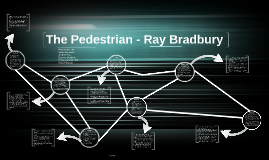
They can be set in the future (such as Octavia Butler’s excellent duet, The Parable of the Sower and … Talents, and Anthony Burgess’ A Clockwork Orange), or set in our world but one changed (Philip K. Dystopias, like their opposite utopia, can come in all shapes and sizes, both on Earth and far away from home. Damaged, counter-productive, oppressive, hostile, empty, soulless. This is a short example of the dystopian form of science fiction (a movement that seems to be growing even today) wherein a society is depicted as negative in some way. One man’s harmless, perhaps even dull, enjoyment of strolling the pavements of his neighbourhood, an action completely unremarkable by itself, becomes a source of concern and transgression to an increasingly isolated society. Despite its simple premise, ‘The Pedestrian’ is loaded with plenty of food for thought. Written by the famed author of Fahrenheit 451 and The Illustrated Man, Ray Bradbury, as mentioned in this story’s introduction, has “more than 400 published stories to his credit” and this is an incredibly short, though effective, example of one of them. Leonard Mead enjoys walking – just walking. Sometimes he wanders by day, but he enjoys his late-night stroll around the neighbourhood, when the streets are deserted and everyone is at home in their dark houses, watching their televisions. There’s nothing Leonard Mead likes more than walking by himself through the streets.

Collected in Brave New Worlds: Dystopian Stories, edited by John Joseph Adams, Night Shade Books, 2011-12, 2nd edition, approx.


 0 kommentar(er)
0 kommentar(er)
